How to Tell if a Cake is Done
This post may contain affiliate links to products I recommend. I receive a small commission at no cost to you if you make a purchase using my link.
Learn how to tell if your cake is done. In a few simple steps, you will know for sure if your cake is cooked all the way through, and prevent undercooked cakes forever! Bonus tips for what to do with an undercooked cake, and how to fix an overbaked cake.
Have you ever baked a cake, given it a quick poke with a finger and had it spring back, or stabbed it with a skewer that comes out clean, then let it cool, cut it, and become completely dismayed to see that it’s undercooked?
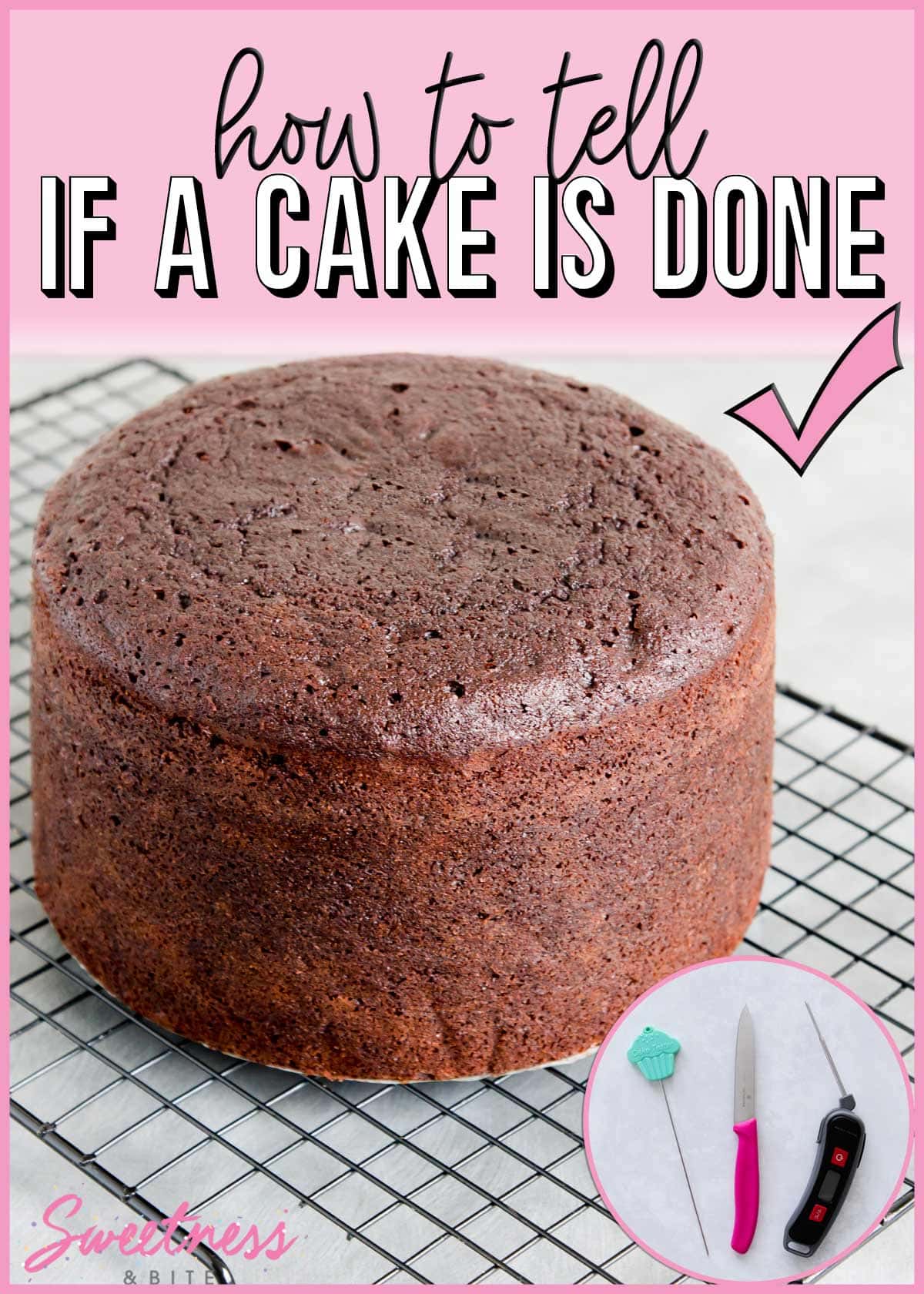
Many cakes, particularly denser, moister cakes like mud cakes, can give you the illusion of being done even when they’re still undercooked in the middle. You might think your cake is done, only to discover that it’s stodgy and undercooked in the middle when you cut into it.
No one likes eating undercooked cake (well, except for licking cake batter off the spoon) and certainly, no one enjoys having to rebake a cake that is supposed to be cooked but isn’t. Luckily there are a few little tips and tricks you can use so you have confidence that when you take the cake out and turn the oven off, your cake will be cooked right through.
To check if your cake is done, you’ll need three simple tools:
1. A skewer/cake tester/toothpick/another kind of pokey stick. I prefer a metal skewer or cake tester, but a bamboo skewer or long toothpick is fine.
2. A thin-bladed knife. Make sure it is a thin blade, right up to the handle, or you’ll make a giant hole in your cake. A small slit in the cake is ok, but a bigger hole may make your cake layers more likely to break. I use my trusty Victorinox paring knives.
3. A probe digital thermometer. This step could be considered optional, but checking the internal temperature is the most accurate way to tell if a cake is done. I really like this Accurite thermometer (pictured below) for checking the internal temperature of a cake as it gives a quick reading, but I also sometimes use my CDN Candy Thermometer. (If you’re buying your first probe thermometer, I recommend buying the candy thermometer, as it’s more versatile.)
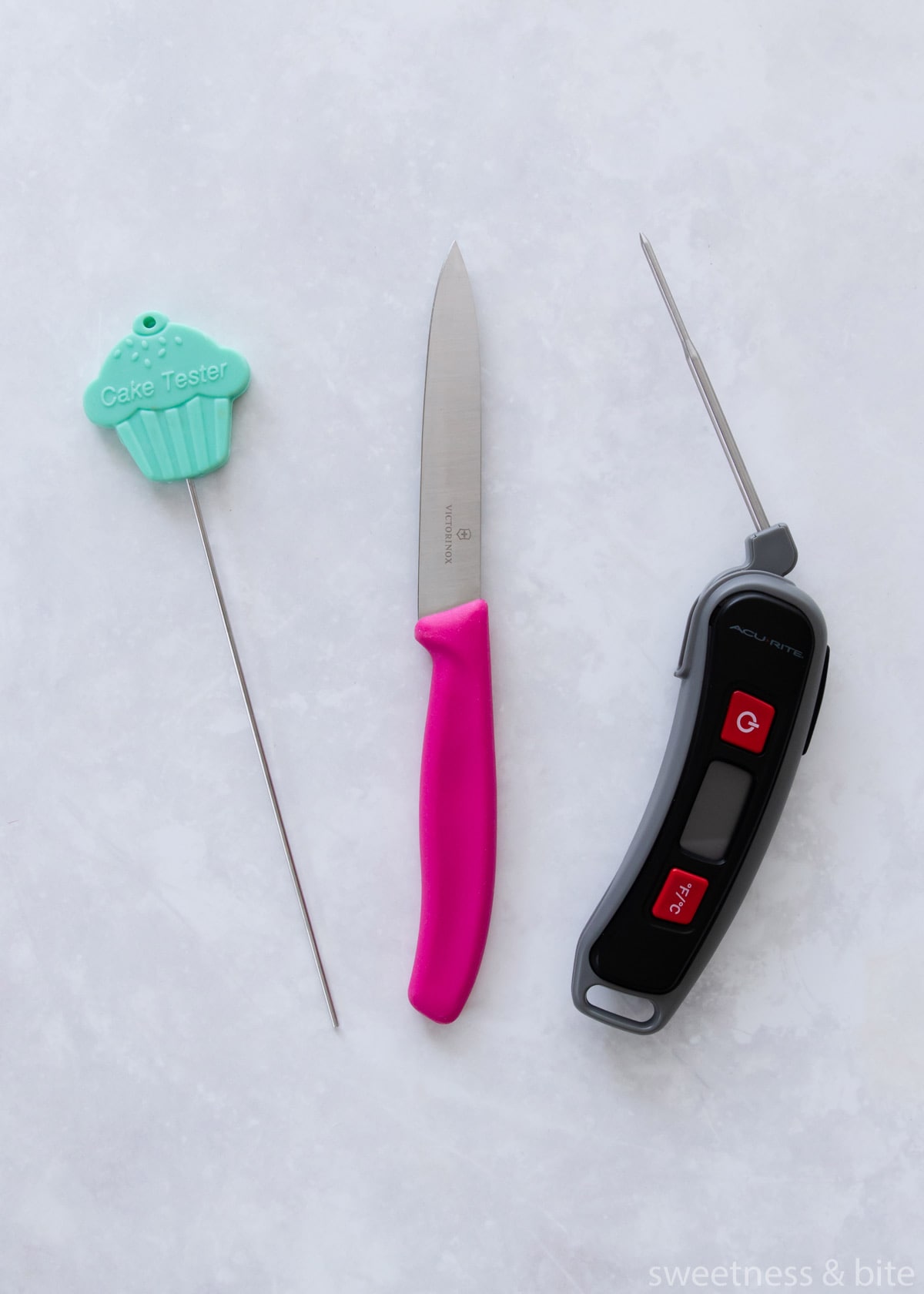
(The Masterchef probe thermometer shown in the photos below has now been commandeered by my Dad for testing meat on the BBQ, so I don’t use it for cakes anymore 😂)
Right, let’s get into the steps!
How to Tell if a Cake is Done
If you’re baking the same size and shaped cake as your recipe and it has a stated time range, start checking the cake at the shortest time. But how do you know when to start checking if you’re baking a bigger/smaller sized cake than the recipe? The “I can smell delicious cake now” test is usually a pretty good indicator. Next, we’ll have a look at the cake through the oven door.
Step 1 – Visual Signs That the Cake is done
Before you start poking things into the cake, make sure it has most of the other signs of a cooked cake.
If, when you go to check the cake, you look in the oven and the cake is clearly not cooked yet then don’t open the oven door – if the cake hasn’t started to set on top yet then opening the door will cause the oven temperature to drop and your cake may well do the same, sinking in the middle.
The first sign to look for is that the top crust looks fully set, and will usually have lost some of the shine on the surface. In lighter coloured cakes, such as vanilla butter cakes and sponge cakes, the edges may have browned slightly.
The cake may also be pulling away slightly from the sides of the tin, and if you gently press the top of the cake with your finger, the cake should spring back.
Once it passes those tests, you can move on to the next step.
Step 2 – Cake Testing Skewer (aka The Toothpick Test)
Once the cake passes the finger press test, insert the skewer into the centre of the cake, right down to the bottom. If it comes out with cake batter and/or very sticky crumbs sticking to it, then the cake needs to cook for longer.
Pop the cake back into the oven. How long you wait to test again will depend on how wet the skewer was when it came out. If it looks like the cake is *almost* done, then you can test again in 5-10 minutes. If it was very wet you can wait longer. You’ll have to use your own discretion here.
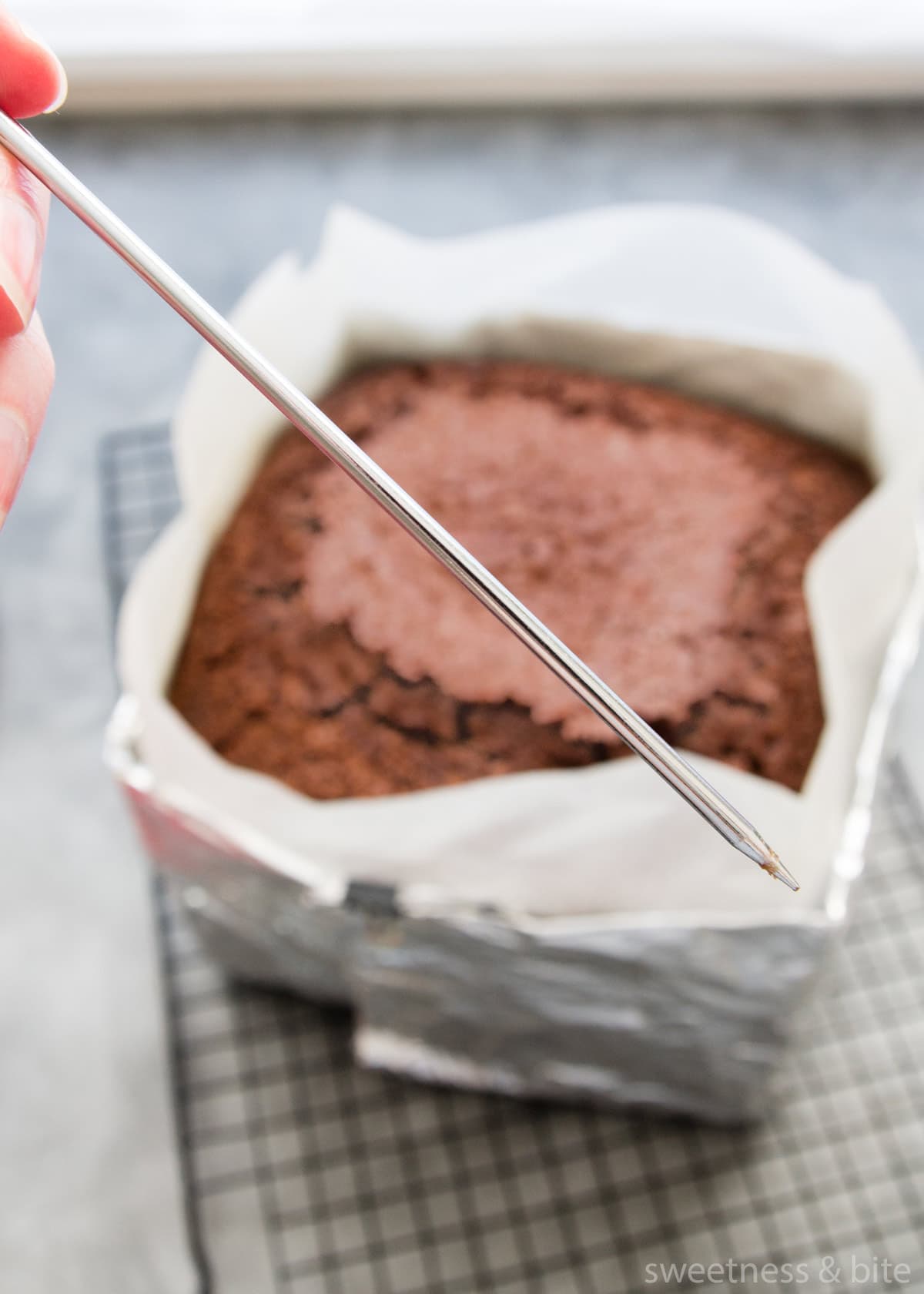
When the skewer comes out clean, you can continue with the next step.
Step 3 – The Knife Test
Insert a thin-bladed knife into the centre of the cake. Often even if a skewer has come out clean, the extra surface area on the knife may still show some uncooked batter, usually on the tip.
In the picture below, you’ll see that the knife is pretty clean, with only a few little crumb specks.
(Please ignore the fact that the top of this cake is cracked, I was lazy and didn’t use a foil lid on the top of the mud cake along with the baking strips, and so it cracked on the top. Don’t be like me. If you’re baking mud cakes, use a foil lid.)
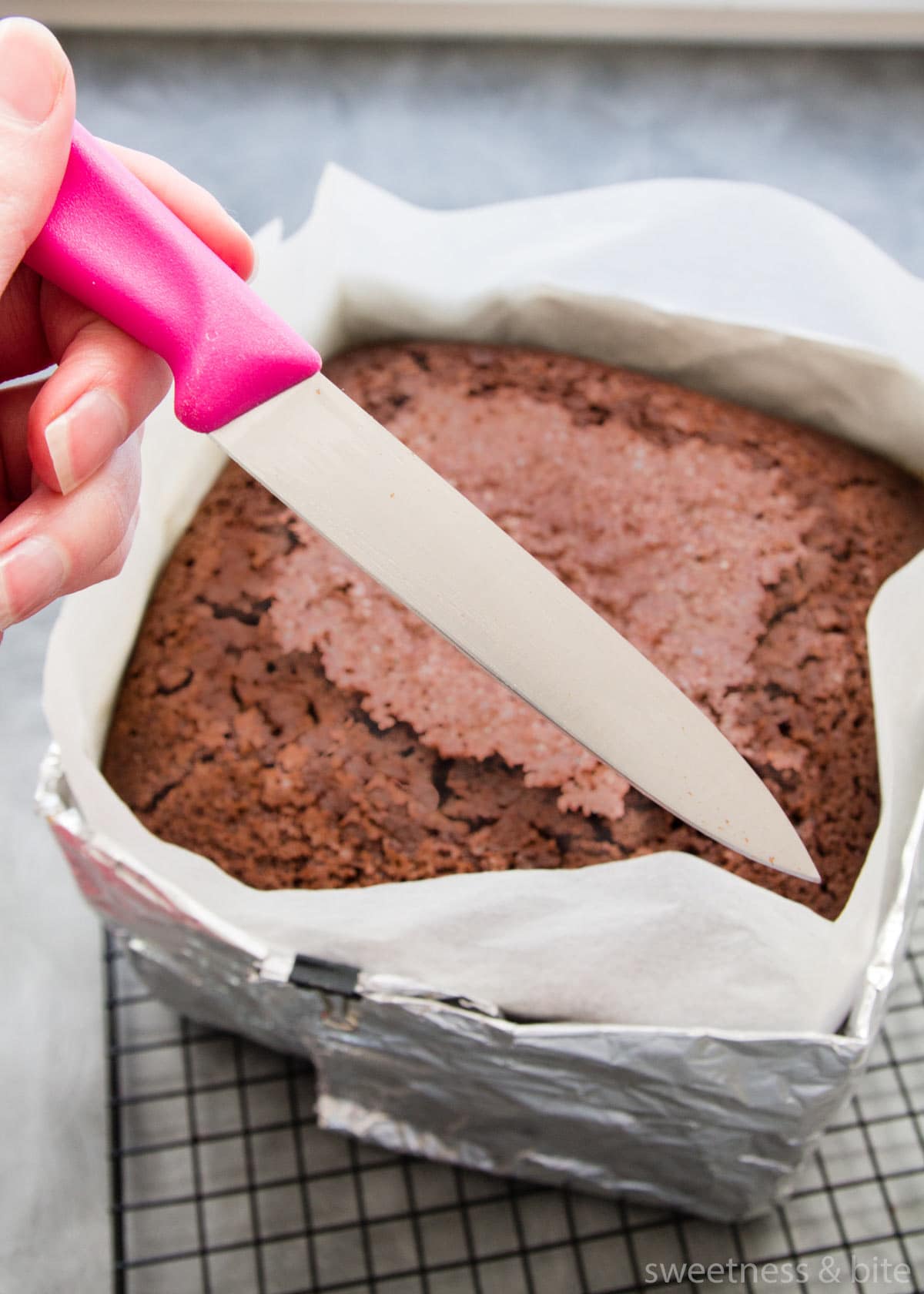
You can stop here if you’re feeling confident the cake is cooked, but if you want to be 100% sure, then…
Step 4 – The Thermometer Test – Internal Cake Temperature
Testing with a probe thermometer is the most accurate way to tell if your cake is done.
Take the cake out of the oven and insert the digital thermometer into the centre of the cake, using the hole the skewer and knife created to avoid having your cake look like a pincushion.
Don’t let the tip of the thermometer touch the bottom of the cake pan or you’ll get an inaccurate reading from the metal, hold it slightly above the bottom. The internal temperature of the cake should be around 99℃ (roughly 210℉).
Sometimes if the cake is 1-2 degrees less, I’ll remove it from the oven, as it will continue to cook a bit more in the tin anyway. But if it’s less than that, it needs to go back in the oven for a bit longer.
If your cake has pieces of fruit in it, like rich fruit cakes / Christmas cakes or chunks of fresh fruit, keep in mind that those pieces of fruit can potentially be hotter than the surrounding cake (because of the sugar in the fruit) so for fruit cakes I usually test the cake in a few places with the thermometer, just to be sure I’m not getting a false reading off a piece of fruit.

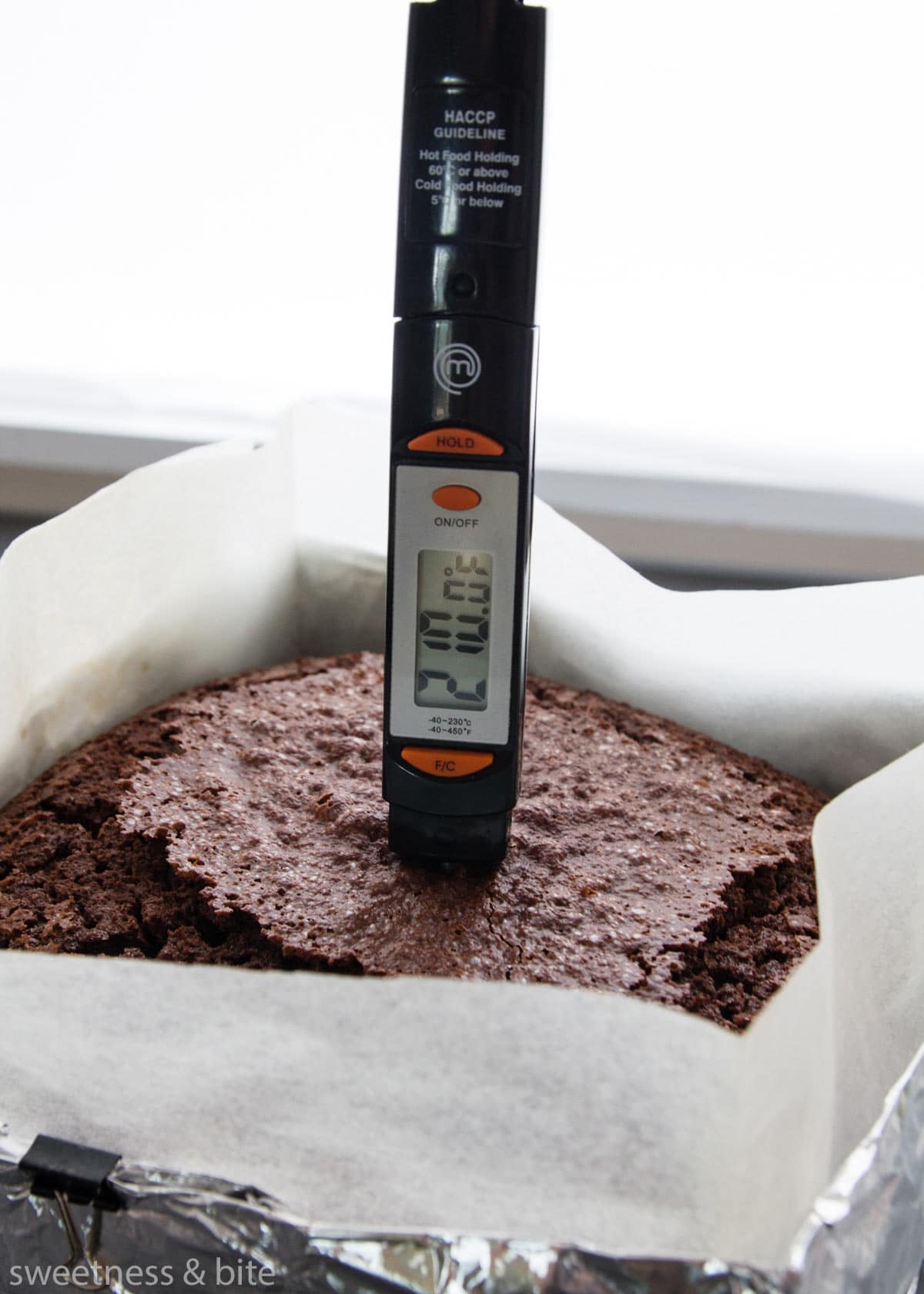
Final step – write down how long the cake took to bake! This way, the next time you bake that cake, in that tin, at that temperature, you’ll have a better indication of how long it will take.
Here’s a bit more helpful information regarding undercooked and overbaked cakes:
Signs of an Undercooked Cake
The first, most instantly noticeable sign of an undercooked cake is sinking in the middle. If you’ve taken the cake out of the oven and left it to cool and it sinks in the middle, that’s usually a sign that the cake is undercooked. A slight dip in the middle doesn’t necessarily mean the cake isn’t cooked, but a big dip is a pretty big sign.
If you slice your cake into layers and have a particularly dense/wet/stodgy patch in the middle, that’s also a sign that the cake isn’t done. A fully cooked cake should be even in texture across the whole cake layer, the crumb should look even, not darker or wetter in patches.
Keep in mind that more dense cakes like chocolate mud cakes may look overly moist in the middle even when they’re fully cooked, and they naturally have a more dense, tighter crumb. That’s why it’s best to check mud cakes with a thermometer to be sure they’re done, as it can be hard to tell just by looking once they’re cooled.
What To Do With an Undercooked Cake
If you’re using the tips above to check if your cake is done, then you shouldn’t end up with an undercooked cake. If at any stage during the checking process the cake isn’t cooked, you can pop it back in the oven for a bit longer.
But, if you’ve stumbled across this post because you’re wondering what to do with an undercooked cake, it’s probably a wee bit late for the cake checking tips.
If your cake has been out of the oven for a while and has started to cool, or if it’s cooled completely, unfortunately, you can’t just pop it back in the oven to finish baking.
I’m sorry to be the one that has to tell you this, but if you’re needing a cake to decorate, you’re going to have to bake another cake. Even if you were to put the cake back in the oven, it still won’t bake properly or rise again in the middle.
Having said that, you don’t necessarily have to throw out the whole cake! If you can *PIVOT!* (Friends fans, raise your hands 🙋♀️), you may be able to use the parts of the cake that are fully cooked.
You can cut off those pieces and use them to make other treats. You can crumble it to make cake pops, or chop it into pieces and use it to make a trifle.
Or you could make something like these Black Forest dessert cups I made a little while ago. I used leftover chocolate cake, used some Ultimate Whipped Cream (but regular whipped cream, ready-made custard or a mixture of both would also work well) and some cherries in syrup (either cherries in a jar or can would work).
If you’re using an undercooked cake, cut off the pieces that are fully cooked, chop them roughly into cubes. Add some to the glass, drizzle in some of the cherry syrup to moisten the cake, then add the cream and cherries, and continue to layer it up to the top of the glass.
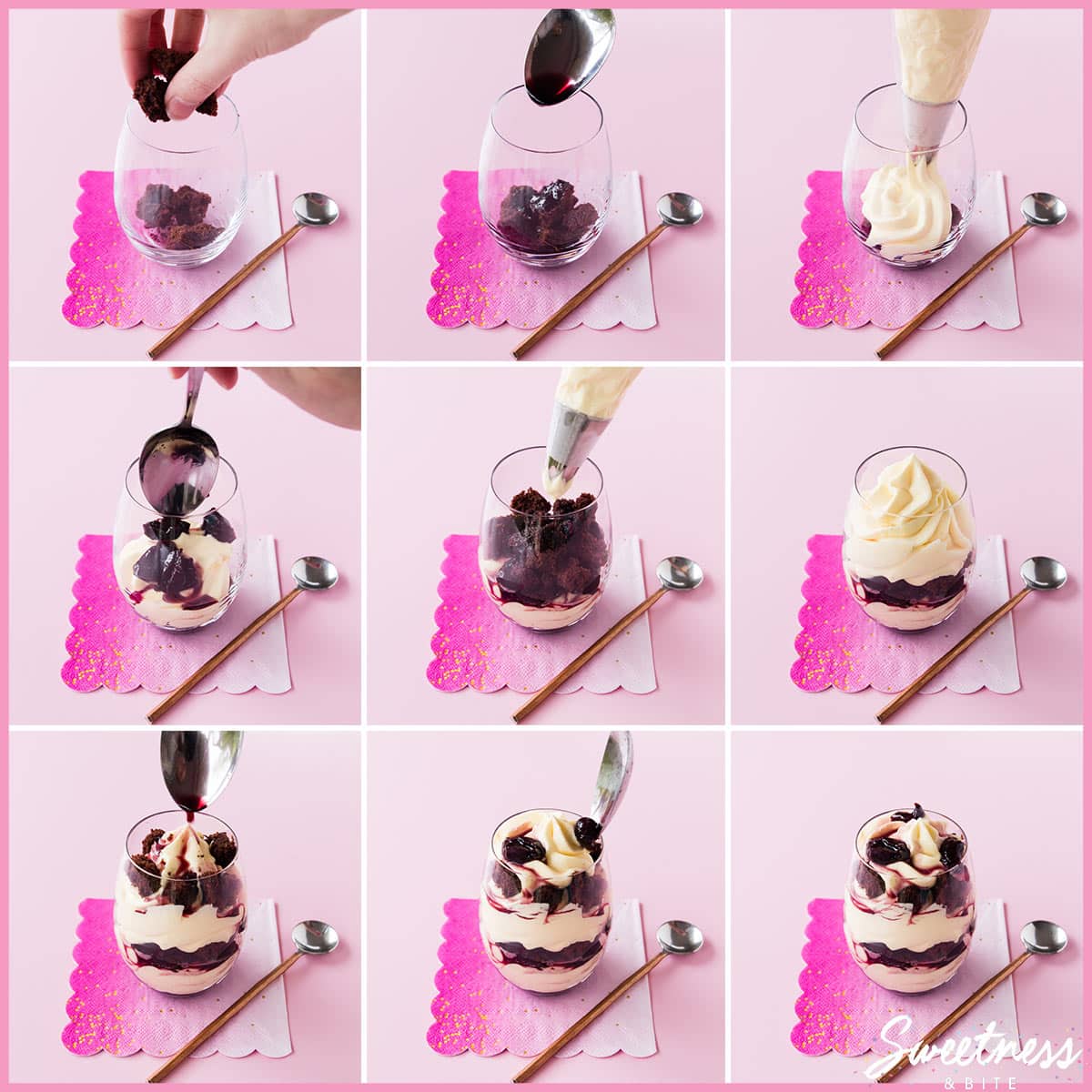
What to Do with an Overbaked Cake
The only thing as disappointing as an underbaked cake is an overbaked and dry cake. An overbaked cake is a little easier to fix though, and you have a few options.
If you realise the cake is overbaked right when you’ve taken it out of the oven (it might look dry and crusty on the top and sides, or if you test it with a thermometer it may be way over 99°C) then my favourite tip is to boil some water and brush it over the top of the cake, letting it run down the sides. You can then pop a piece of foil over the cake, and leave it to cool. This will soften the crust of the cake, and add moisture back into it.
If you realise it’s dry when you’re splitting your cake into layers to add a filling, then it’s a great idea to use a sugar syrup on the cake layers. I have a whole post on sugar syrup for cakes and how to use it, so I highly suggest checking that out for all the info.
If your cake is a little burnt, but only around the edges, then you’ll need to trim off all the burnt crusts. This may mean your cake ends up a lot smaller, but at least you’ll still be able to eat it. If you’re decorating your cake with ganache or buttercream, you may need to go down a cake board size. I would recommend splitting the cake into layers and adding some sugar syrup to them as well, for extra moisture.
Here’s a quick cheat sheet with the cake checking steps:
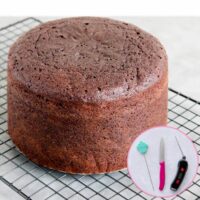
How To Tell If a Cake Is Done
Equipment
- Cake tester or a metal or bamboo skewer
- Thin-bladed knife
- Probe thermometer
Instructions
- Check for the visual signs that the cake is done:The top crust should look fully set, and will usually have lost some of the shine on the surface.Lighter coloured cakes, like vanilla butter cakes or sponge cakes, may have browned slightly at the edges. The edges of the cake may also be pulling away from the pan. If you press the surface of the cake with a finger, it should bounce back.
- Check with the skewer:Insert it into the middle of the cake. If it comes out clean, or with a few crumbs attached, move on to the next step. If it has wet batter on the skewer, put it back in the oven for longer.

- Check with the knife:Insert the knife into the middle of the cake. Look for the same signs as with the skewer. If the knife comes out clean, move on to the last step.

- Check the internal temperature of the cake:This is the most accurate way to tell if your cake is done. Insert the probe thermometer into the middle of the cake. Make sure it's not touching the bottom of the cake pan. The internal temperature of the cake should be at least 99°C or around 210°F.

Lastly, write down how long the cake took to bake. That way you'll know for next time you bake that recipe in that sized pan.
So there you have it, now you’ll know how to tell if your cake is done, and a few ways to fix the situation if your cake is underbaked or overbaked.
Happy baking!
(And let’s face it, if you’ve minimised one thing that could make it unhappy, then that happy is lookin’ more likely, right?!)
You May Also Like…
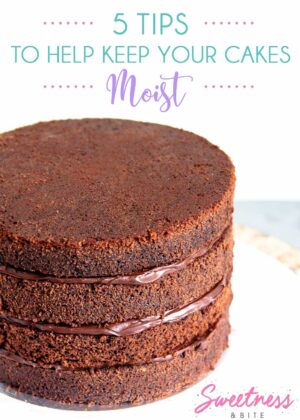


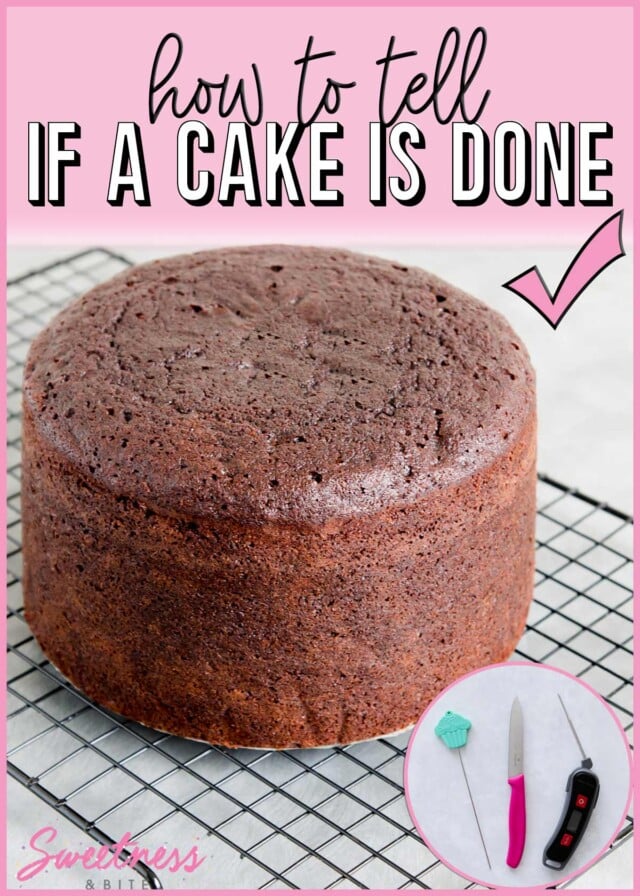
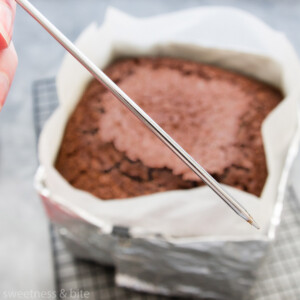
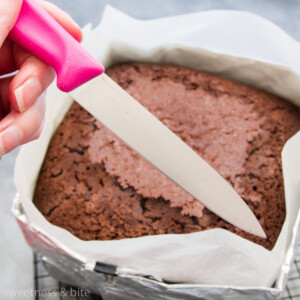
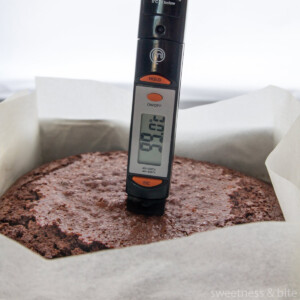
I love your tutorials…and here’s the BUT…the proper term and a pet peeve of mine is “BAKED a cake”! BAKING is done in the oven and COOKING is done on the stove/cooktop/range!
Wow, we all have pet peeves but no need to get all intense over it haha! Sometimes, especially when someone has put a huge amount of effort and love in to something it’s best to just let it go 🙂
Fantastic tutorial!! And so beautifully presented xx
Precision is important in all things, definitely in baking, but in language too.
Thank you for the tips; I have a new frigidaire oven that heats unevenly and has been a baking nightmare. Two of the exact same pans, filled with the same batter will come out one baked and one wet in the middle. These methods will save me time, money, and frustration.
❤️❤️❤️
Actually, Susan Hardy is correct and while I do understand your reply, this is a tutorial and, therefore, one would expect the correct terminology to be used. Cakes are always baked.
The definition of cooking is the practice or skill of preparing food by combining, mixing, and heating ingredients. Baking is cooking. Baking is just a more specific term for cooking. You can cook any food, but not all foods can be baked.
Exactly, which is why one uses the term baking, when baking. Thank you for making it so clear
thanks for your time and effort in sharing this and all your tutorials. Baked or cook is perfectly understandable.
Great Tutorial Clear easily understandable. Love using the digital choice. Works everytime
Really good tips! Baking is both art and science – new bakers are well served by using the good advice of experience. I learned how to cook and bake at her bedside as she was ill with breast cancer. I, to this day, still use her loving tips and techniques.
Hi Natalie, I have increased the recipe (using the Cakeometer – great tool!) for an 11 inch cake tin. Can you please advise roughly how long it would take to cook? Thanks!
Hi Polly, which recipe is it that you’re using? If you have the CakeOmeter app then it has a section to tell you how to adjust the cooking time, if you don’t have the app and you’re using the website I don’t think it tells you, but if you let me know what recipe it is that you’re adjusting I can look it up on the app for you. I usually just end up going by smell though, when I start smelling the cake it’s time to start checking it 😉
Hi Natalie, it was for the dark chocolate mud cake. I took a gamble and checked it after 3 hours and then gave it another 30mins and it worked out fine 🙂 I’m now onto the ganache part – and then it will be the fondant (wrapped) – all following your great tutorials! Many thanks!
Hi Polly, that’s great, I’m so glad to hear it worked out! I hope the rest of the cake goes just as smoothly 🙂 x
Smoothly being the operative word!
Exactly! 🙂 <3
Hi Polly!! Love this!!
Might sound silly but could you skip the skewer and knife test and just use the thermometer? Thanks!
– Jess
Hi Natalie!!****
Sorry!!
– Jess
Hi Jess, yep you can skip straight to the thermometer if you wish 🙂 I usually start with the skewer because I can use that quickly while the cake is still in the oven, so I can just leave the cake in if it’s not cooked yet. It’s also easier to clean the skewer than the thermometer if it comes out with sticky cake batter on it 😉 But if you’re pretty sure the cake is nearly done, you can take it out and test straight away with the thermometer.
This was really useful thankyou 🙂
Hi Natalie,
Please help!! Been having an issue lately &I can’t seem to figure out what’s going wrong. My knife is coming out clean but once I cut the cake & it’s not baked at all or evenly. Using an 8×3 sandwich tin for a simple chocolate cake (250g flour+sugar+butter, 4eggs,cocoa, baking soda). Baking it at 160degress fan oven for 30 mins. It’s spongey but not evenly baked 🙁 Stressed as this has never happened before.
Thanks,
Heenal
Sorry was meant to say Natalie,
No worries, I fixed it for you 🙂
Hi Heenal. I’m guessing it just needs a bit longer than 30 minutes to be fully baked. That’s not a very long baking time at 160 degrees even on fan bake. I’d try increasing the baking time to 40-45 minutes and go from there. Also there’s the possibility that your oven runs a bit cold, so the actual temperature of the oven as the cake bakes may not be 160 degrees. If you can get an oven thermometer then I highly recommend it, to make sure that your oven is at the right temperature. And if you can get your hands on a probe thermometer then you’ll know for sure if the centre of the cake is cooked. Hope that helps!
Thank you for your reply! I will get them today and increase the baking time aswell. 🙂
Heenal x
You’re most welcome, good luck and I’d love to know how you go with it 🙂
Hi there,
I always struggle knowing if my christmas fruit cake is cooked properly. Is an internal temp of 99 C for all cakes or does it differ depending on what kind of cake you are cooking? Other website suggested an internal temp of 93 C for fruit cake.
Thanks
Hi Rebekah, fruit cakes are definitely a pain to judge when they’re done! I use 99°C (or near enough) for all my cakes, including fruit cakes. The issue with fruit cakes is that the pieces fruit can get a lot hotter than the surrounding cake batter, if the thermometer probe is reading off a chunk of fruit it can be a higher temperature than the actual cake batter. So I tend to take the temperature in a few different spots around the middle of the cake and then average it out to see if it needs to stay in longer. With fruit cakes though I would rather err on the side of slightly under-baked than over-baked, they will continue cooking for a while after they come out of the oven. Hope that helps 🙂
Thanks so much for your prompt reply 🙂 Yes your very helpful.
My fruit cake recipe has more fruit than batter I think – so 99 C or near enough sounds good to me! Thanks! Yes, I do prefer to undercook than overcook my fruit cake.
Trying to bake a Gluten Free And Vegan cake! If I baked a cake and used the knife method to check if it was finished baking, there was no batter on the knife.. But after I took the cake out of the oven and let it cool I noticed it was still raw in the middle what went wrong?
Hi Courtney. Some cakes can be difficult to tell if they are cooked or not using the skewer or knife. If you can get your hands on a probe thermometer you’ll be able to make sure they cake is hot enough in the middle to be cooked. It could also be an issue with the recipe, but I’d suggest starting with making sure the cake is getting to the right temperature in the middle before changing or messing with the recipe. Hope that helps 🙂
What’s a good inside temp for banana nut bread in loaf pan? I’m thinking 185 f. Is that about correct? Ray
Hi Ray, I use the same temperature for most cakes and loaves, 99℃ (roughly 210℉).
Thanks! My vintage recipe worked very well! Very moist and done all through! Ray
That’s great! I’m glad to hear it 🙂
Kudos too you, Natalie. Very few bakers bake to the internal temperature, which is the only sure way to know when a cake is baked in the center. I remind my students that when a liquid reaches 212 degrees it is boiling, and any cake which is that hot internally is losing its liquid content to evaporation and is drying out. I also caution them that a cake, cookie, etc. will continue to bake a little once out of the oven. Thanks for including this tip on your post, and educating our up and coming bakers.